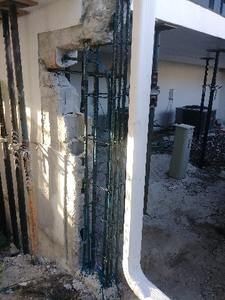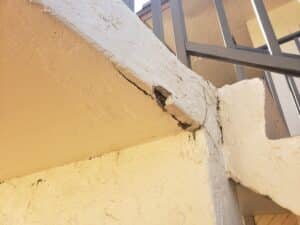In the tapestry of architectural wonders, concrete and stucco stand as enduring pillars, shaping the landscapes of our cities and communities. However, time and nature’s relentless forces can leave their mark on these majestic structures, etching tales of wear and tear onto their surfaces. Enter the realm of concrete and stucco restoration—a blend of art, science, and meticulous craftsmanship.
That’s why we’re here to unravel the intricacies of concrete and stucco restoration, specifically tailored for Condo-HOAs and commercial properties. Together, we’ll explore innovative techniques, delve into the nuances of material selection, and uncover the secrets behind preserving and enhancing the structural integrity and aesthetic appeal of your prized assets.
Whether you are a property manager, a homeowner, or simply passionate about maintaining the beauty and functionality of your surroundings, this guide is your trusted companion. Read on as we unveil the transformative power of concrete and stucco restoration, ensuring that your properties continue to stand tall and radiant for generations to come.
Common Concrete and Stucco Issues
To effectively address concrete and stucco problems, it is essential to be aware of the common issues that can plague these foundational building materials:
1. Cracks: A variety of factors, such as building settlement, temperature fluctuations, and shrinkage, can lead to cracks in both concrete and stucco surfaces.
2. Spalling: Caused by freeze-thaw cycles, corrosive chemicals, and moisture infiltration, spalling occurs when concrete or stucco surfaces become pitted and flaky.
3. Efflorescence: The presence of soluble salts and moisture can cause white, powdery deposits known as efflorescence, which can degrade the appearance of concrete and stucco facades.
4. Water Damage: Prolonged exposure to moisture can lead to water damage, which can cause various issues in both concrete and stucco surfaces, including dampness, mold, and structural deterioration.
Repair Techniques
Implementing appropriate repair techniques ensures the successful rehabilitation and longevity of your building’s concrete and stucco surfaces:
1. Crack Repairs: For small cracks, apply a high-quality, flexible sealant specifically designed for concrete or stucco surfaces. Larger cracks may require more extensive repair work, including the use of specialized patching materials or professional guidance.
2. Spalling Repairs: To address spalling, remove loose or damaged material, clean the area thoroughly, and apply a suitable repair mortar designed for concrete or stucco restoration.
3. Efflorescence Removal: Remove efflorescence deposits by gently brushing the surface with a stiff-bristled brush, followed by applying a mild acid solution and rinsing thoroughly with water. Consult with a professional if unsure of the correct acid solution or technique.
4. Water Damage Restoration: Address water damage by first identifying and eliminating the moisture source. Subsequently, remediate the affected area using specialized drying equipment, sealants, and coatings as necessary.
Preventative Measures
Proactive preventative measures are key to minimizing future concrete and stucco issues:
1. Regular Inspections: Periodically examine your building’s concrete and stucco surfaces for signs of wear, damage, or moisture intrusion. Immediate action upon detecting potential problems can save time and money in the long run.
2. Proper Drainage: Ensure your property has effective drainage systems in place to direct water away from concrete and stucco surfaces, reducing the risk of water damage and related issues.
3. Sealants and Coatings: Utilize high-quality, water-repellent sealants and coatings to provide an additional layer of protection against water infiltration and other damaging elements.
4. Building Maintenance: Maintain your building’s exterior components, such as gutters, downspouts, and roof flashings, to prevent moisture infiltration that could damage your concrete and stucco surfaces.
When to Seek Professional Help
Although some concrete and stucco problems can be addressed with DIY solutions, there are instances where professional assistance is necessary:
1. Structural Issues: If cracks or deterioration affect your building’s load-bearing components or severely compromise structural integrity, contact a professional contractor immediately.
2. Extensive Damage: Large-scale damage, such as significant spalling or deep, widespread cracking, may require professional assessment and restoration to ensure effective and long-lasting repairs.
3. Persistent Efflorescence: If efflorescence deposits persist despite your best efforts, a professional evaluation can help identify the underlying issue and provide targeted, effective solutions.
4. Equipment and Expertise: Some repair techniques require specialized equipment and knowledge, which may be beyond the skill set of most property owners or managers. Trust a professional contractor to provide the necessary expertise and resources to address complex restoration projects.
Restoring Concrete and Stucco: A Comprehensive Guide for Condo-HOAs and Commercial Properties
Maintaining and enhancing your Condo-HOA or commercial property’s exterior is crucial for the overall well-being and value of your investment. By understanding the common issues that affect concrete and stucco surfaces and implementing effective repair techniques and preventative measures, you can be confident that your building’s exterior will remain in top condition.
Remember that while DIY methods may suffice for minor issues, seeking professional help for more complex or severe problems can be a critical investment in the long-term success of your property.
Reach out to McLeod’s Contracting Solutions today for a free consultation and expert guidance on your concrete and stucco restoration needs, and let our skilled team of concrete contractors in Naples, FL, restore your property’s exterior to its former glory with our unparalleled expertise and commitment to quality.







